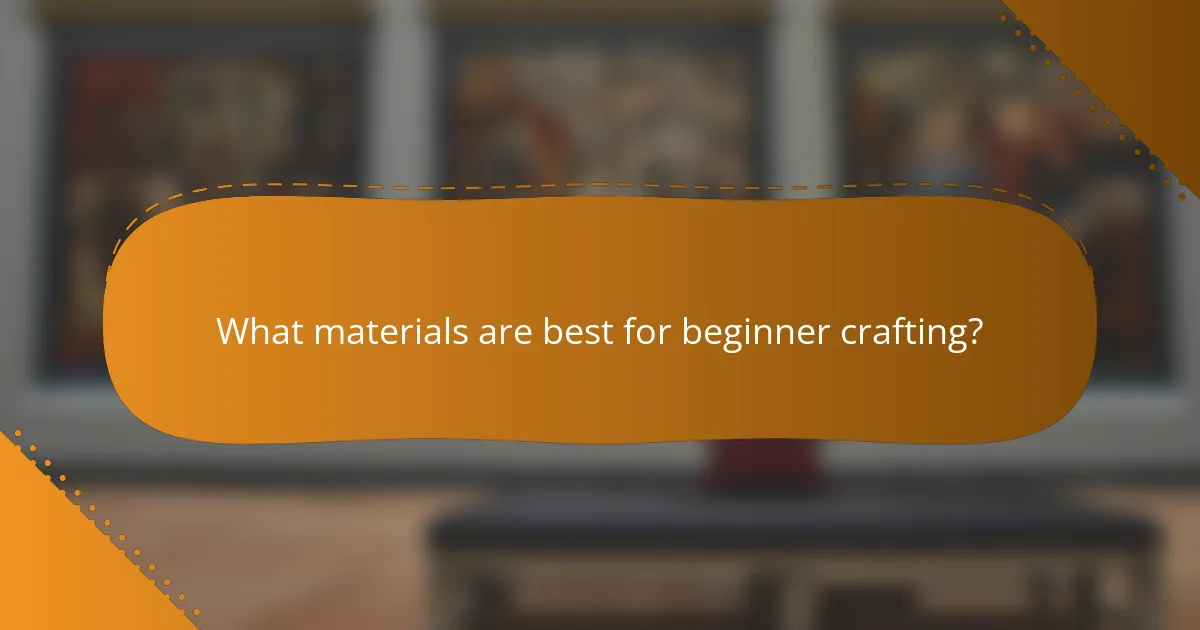Choosing the right materials for beginner crafting is essential for a successful and enjoyable experience. Look for options that are easy to handle, budget-friendly, and versatile, such as cotton fabric, cardstock, and air-dry clay. Additionally, evaluating the quality of these materials through brand reputation and customer reviews can ensure safety and reliability. Keeping an eye on costs and potential discounts will help you stay within budget while exploring your creative projects.

What materials are best for beginner crafting?
For beginner crafting, the best materials are those that are easy to work with, affordable, and versatile. Cotton fabric, cardstock paper, wooden craft sticks, air-dry clay, and beads with jewelry wire are excellent choices that cater to various projects and skill levels.
Cotton fabric
Cotton fabric is a popular choice for beginners due to its ease of handling and availability in various colors and patterns. It can be used for sewing projects, quilting, or even simple crafts like fabric flowers. Look for pre-cut fabric squares or fat quarters, which are often affordable and perfect for small projects.
When selecting cotton fabric, consider the weight and texture. Lightweight cotton is easier to sew, while heavier options are better for structured items. Always wash and iron fabric before starting your project to ensure it is clean and smooth.
Cardstock paper
Cardstock paper is a thicker, more durable paper ideal for crafting projects like greeting cards, scrapbooking, and paper models. It comes in various colors and finishes, making it suitable for both decorative and functional items. For beginners, a pack of assorted colors can provide a good variety for different projects.
When working with cardstock, use a sharp craft knife or scissors for clean cuts. A paper trimmer can also be helpful for straight edges. Be mindful of the weight of the cardstock; 80 lb to 110 lb is a good range for most beginner projects.
Wooden craft sticks
Wooden craft sticks, often referred to as popsicle sticks, are inexpensive and versatile materials for crafting. They can be used to create structures, frames, or even simple toys. A pack of craft sticks can usually be found at craft stores for a low price, making them accessible for beginners.
To enhance your projects, consider painting or decorating the sticks before assembly. Hot glue or craft glue works well for joining sticks together. Be cautious with hot glue, as it can cause burns if not handled properly.
Air-dry clay
Air-dry clay is an excellent material for beginners interested in sculpting or creating three-dimensional projects. It is easy to mold and does not require baking, making it convenient for home use. Once dry, air-dry clay can be painted or sealed for a finished look.
When working with air-dry clay, keep it covered when not in use to prevent it from drying out. Start with small projects, like ornaments or simple figurines, to build your skills. Remember that drying times can vary, so allow adequate time for your creations to harden completely.
Beads and jewelry wire
Beads and jewelry wire are perfect for beginners interested in making jewelry or decorative items. A variety of beads, including glass, plastic, and wooden options, are available in craft stores. Jewelry wire comes in different gauges, with 20 to 24 gauge being suitable for most beginner projects.
When creating jewelry, start with simple designs like bracelets or necklaces. Use crimp beads to secure wire ends and ensure your pieces are durable. Always check for sharp edges on wire to avoid injury while crafting.

How to assess the quality of crafting materials?
To assess the quality of crafting materials, consider factors such as brand reputation, material durability, safety certifications, and customer reviews. Evaluating these aspects will help ensure you choose reliable and safe supplies for your projects.
Brand reputation
Brand reputation plays a crucial role in determining the quality of crafting materials. Established brands often have a history of producing reliable products, while newer or lesser-known brands may lack proven track records. Researching brands through their websites and social media can provide insights into their reliability.
Look for brands that are well-reviewed by crafters and have a strong presence in the crafting community. Recommendations from experienced crafters can also guide you toward reputable brands.
Material durability
Material durability refers to how well crafting supplies withstand wear and tear during use. For example, fabrics should be able to resist fraying, while paints should not chip or fade easily. Assessing durability can save you money in the long run by reducing the need for frequent replacements.
When selecting materials, consider their intended use. For projects requiring longevity, opt for higher-quality materials, even if they come at a higher price point. A good rule of thumb is to choose materials that come with warranties or guarantees.
Safety certifications
Safety certifications indicate that crafting materials meet specific safety standards, which is especially important for projects involving children or sensitive individuals. Look for certifications like ASTM, EN71, or CE, which ensure that materials are non-toxic and safe for use.
Always check product labels for safety certifications. If you are unsure about a material’s safety, consult the manufacturer’s website or contact customer service for clarification.
Customer reviews
Customer reviews provide valuable insights into the quality and performance of crafting materials. Reading reviews can help you identify common issues or benefits associated with a product. Look for reviews on reputable crafting websites or platforms like Amazon.
Pay attention to both positive and negative feedback. A product with a high number of reviews and an overall positive rating is generally a safer choice. Consider the context of reviews as well; for instance, a low rating due to shipping issues may not reflect the product’s quality.

What are the cost considerations for crafting materials?
When choosing crafting materials, cost considerations play a crucial role in budgeting for projects. Factors such as bulk purchasing, local store pricing, online comparisons, and seasonal promotions can significantly impact overall expenses.
Bulk purchasing discounts
Buying materials in bulk often leads to significant savings. Many suppliers offer discounts ranging from 10% to 30% for larger quantities, making it a smart choice for frequent crafters. Consider pooling orders with friends or local crafting groups to maximize these savings.
However, ensure that the materials have a long shelf life or that you have enough projects planned to use them up. Storing excess supplies can lead to clutter and waste if not managed properly.
Local craft store pricing
Local craft stores typically have a wide variety of materials, but prices can vary significantly. It’s common to find basic supplies like paper, paint, and fabric priced higher than online options. Always check for loyalty programs or membership discounts that can help reduce costs.
Additionally, keep an eye out for clearance sections or weekly sales that can offer substantial savings on popular items. Visiting multiple stores can also help you compare prices and find the best deals.
Online retailer comparisons
Shopping online provides the advantage of easily comparing prices across multiple retailers. Websites often feature customer reviews, which can help gauge the quality of materials before purchasing. Look for sites that offer free shipping or bulk discounts to further reduce costs.
Be mindful of return policies when buying online, as some retailers may have stricter guidelines. Factor in shipping times and costs when planning your projects to avoid delays.
Seasonal sales and promotions
Seasonal sales can be an excellent opportunity to stock up on crafting materials at reduced prices. Events like Black Friday, back-to-school sales, and holiday promotions often feature significant discounts on popular items. Mark your calendar to take advantage of these opportunities.
Joining mailing lists or following craft stores on social media can keep you informed about upcoming sales and exclusive promotions. This proactive approach can lead to substantial savings over time.

What are the essential tools for beginner crafting?
Essential tools for beginner crafting include basic items that facilitate various projects. These tools help ensure safety and precision, making the crafting experience enjoyable and productive.
Scissors
Scissors are a fundamental tool for any crafter, used for cutting paper, fabric, and other materials. When selecting scissors, consider the type of projects you will undertake; fabric scissors are designed for cloth, while paper scissors are best for paper products.
Look for scissors that fit comfortably in your hand and have a sharp blade for clean cuts. A good pair of scissors typically costs between $5 and $20, depending on the brand and quality.
Glue gun
A glue gun is an essential tool for bonding materials together quickly and effectively. It uses hot glue sticks that melt when heated, allowing for a strong adhesive bond on various surfaces like paper, wood, and plastic.
When choosing a glue gun, consider the size and wattage; a standard 20-watt glue gun is suitable for most beginner projects. Expect to spend around $10 to $30 for a decent glue gun, plus additional costs for glue sticks.
Cutting mat
A cutting mat protects your work surface while providing a stable base for cutting materials. It is especially useful for projects involving precise cuts, as it helps prevent damage to tables and extends the life of your cutting tools.
Look for a self-healing cutting mat that can withstand repeated cuts without showing wear. Prices typically range from $15 to $50, depending on the size and thickness of the mat.
Paintbrushes
Paintbrushes are vital for applying paint, glue, or other mediums in crafting. They come in various shapes and sizes, each suited for different applications, such as detail work or broad strokes.
For beginners, a basic set of brushes that includes flat, round, and detail brushes is recommended. A good quality set can cost between $10 and $30, allowing you to experiment with different techniques and materials.

How to choose materials based on crafting projects?
Choosing materials for crafting projects involves considering the type of project, the quality of materials, and their cost. Understanding these factors helps ensure that your crafting experience is enjoyable and successful.
Project type considerations
The type of crafting project significantly influences the materials you should select. For example, if you are working on a sewing project, you will need fabric, thread, and possibly interfacing, while a woodworking project will require different types of wood, glue, and finishing supplies. Each project type has specific material requirements that can affect the final outcome.
Consider the durability and finish of materials based on the intended use of the final product. For instance, if you are creating items for outdoor use, opt for weather-resistant materials. Always check product descriptions for suitability to ensure the materials align with your project goals.
Skill level matching
Your crafting skill level should guide your choice of materials. Beginners may benefit from using less expensive, easy-to-handle materials that allow for mistakes without significant loss. For example, using acrylic paint instead of high-end oil paints can provide a more forgiving experience for novice painters.
As you gain experience, you can transition to higher-quality materials that may offer better results but require more skill to work with. Always assess your comfort level with different materials and techniques before committing to a project, and don’t hesitate to seek advice from more experienced crafters.


